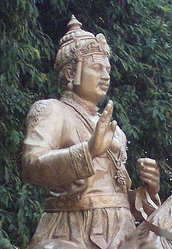
Back লিঙ্গায়েত ধর্ম Bengali/Bangla Lingaiatisme Catalan Lingajáta Czech Lingayatismus German Lingayatismo Spanish لینگایاتیسم Persian Lingayatisme French लिंगायत मत Hindi Lingájatok Hungarian Linggayatisme ID
 Basava, 12th-century statesman, philosopher, poet and Lingayat saint | |
| Founder | |
|---|---|
| Basava (1131–1167 CE) | |
| Regions with significant populations | |
| Karnataka | 15,893,983[note 1][1] |
| Maharashtra | 6,742,460[note 2][1] |
| Telangana | 1,500,000[note 3][2] |
| Religions | |
| Hinduism (Shaivism) | |
| Scriptures | |
| Vachana sahitya • Karana Hasuge • Basava purana • Shunyasampadane • Mantra Gopya • Siddhanta Shikhamani | |
| Languages | |
| Kannada • Marathi[3] | |
| Related ethnic groups | |
| Kannadigas • Marathi[3] | |
 |
| Part of a series on |
| Lingayatism |
|---|
| Saints |
| Beliefs and practices |
| Scriptures |
| Pilgrim centers |
| Related topics |
|
|
Lingayatism is a Hindu denomination based on Shaivism.[4][5][6][web 1] Initially known as Veerashaivas, since the 12th-century adherents of this faith are known as Lingayats.
Lingayatism is known for its unique practice of Ishtalinga worship, where adherents carry a personal linga symbolizing a constant, intimate relationship with Shiva.[7] A radical feature of Lingayatism is its staunch opposition to the caste system and advocacy for social equality, challenging societal norms of the time.[8] Its philosophical tenets are encapsulated in Vachanas, a form of devotional poetry.[9] The tradition also emphasizes Kayaka (work) and Dasoha (service) as forms of worship, underscoring the sanctity of labor and service to others.[10] Unlike mainstream Hinduism, Lingayatism rejects scriptural authority of vedas and puranas,[11] ritualistic practices, and the concept of rebirth, promoting a direct, personal experience of the divine.[12]
Lingayatism is generally considered a Hindu sect[13][web 1][note 4] because their beliefs include many Hindu elements.[14][note 5] Worship is centered on Shiva as the universal god in the iconographic form of Ishtalinga.[15][6][note 6] Lingayatism emphasizes qualified monism, with philosophical foundations similar to those of the 11th–12th-century South Indian philosopher Ramanuja.[web 1]
Contemporary Lingayatism is influential in South India, especially in the state of Karnataka.[6][16] Lingayats celebrate anniversaries (jayanti) of major religious leaders of their sect, as well as Hindu festivals such as Shivaratri and Ganesh Chaturthi.[17][18][19] Lingayatism has its own pilgrimage places, temples, shrines and religious poetry based on Shiva.[20] Today, Lingayats, along with Shaiva Siddhanta followers, Naths, Pashupatas, Kapalikas and others constitute the Shaivite population.[web 2][note 7]
Cite error: There are <ref group=note> tags on this page, but the references will not show without a {{reflist|group=note}} template (see the help page).
- ^ a b "CM Devendra Fadnavis to get demand for Lingayat quota examined by state panel". The Times of India. 23 July 2019. Archived from the original on 5 August 2021. Retrieved 5 August 2021.
- ^ "Telangana state has around 15 lakh Lingayat population". 20 April 2018. Retrieved 20 April 2018.
- ^ a b Shankaragouda Hanamantagouda Patil (), Community Dominance and Political Modernisation: The Lingayats, p.176
- ^ a b Dalal 2010, p. 208-209.
- ^ Schouten 1995, p. 6.
- ^ a b c Fisher, Elaine M. (August 2019). Copp, Paul; Wedemeyer, Christian K. (eds.). "The Tangled Roots of Vīraśaivism: On the Vīramāheśvara Textual Culture of Srisailam". History of Religions. 59 (1). University of Chicago Press for the University of Chicago Divinity School: 1–37. doi:10.1086/703521. ISSN 0018-2710. JSTOR 00182710. LCCN 64001081. OCLC 299661763. S2CID 202376600.
- ^ Ramanujan, A. K. (Ed.). (1973). Speaking of Śiva (Vol. 270). Penguin.
- ^ Schouten, J. P. (1995). Revolution of the mystics: On the Social Aspects of Vīraśaivism. Motilal Banarsidass Publishers.
- ^ Rice, E. P. (1982). a History of Kannada literature. Asian educational services.
- ^ Ishwaran, K. (1981). Bhakti Tradition and Modernization: the case of Lingayatism. In Tradition and Modernity in Bhakti Movements (pp. 72-82). Brill.
- ^ Schouten 1995, pp. 52–56.
- ^ Ramanujan, A. K. (Ed.). (1973). Speaking of Śiva (Vol. 270). Penguin.
- ^ Levinson & Christensen 2002, p. 475.
- ^ Ramanujan 1973, p. 175.
- ^ Dalal 2010, p. 208–209.
- ^ Gall & Hobby 2009, p. 567–570.
- ^ Cite error: The named reference
Patil34was invoked but never defined (see the help page). - ^ Cite error: The named reference
campbell149was invoked but never defined (see the help page). - ^ Srinivas, M.N. (1995). Social Change in Modern India. Orient Blackswan. pp. 157–158. ISBN 978-81-250-0422-6. Archived from the original on 15 April 2021. Retrieved 27 September 2018.
- ^ Wolf, Herbert C. (1978). "The Linga as Center: A Study in Religious Phenomenology". Journal of the American Academy of Religion. XLVI (3). Oxford University Press: 369–388. doi:10.1093/jaarel/xlvi.3.369.
Cite error: There are <ref group=web> tags on this page, but the references will not show without a {{reflist|group=web}} template (see the help page).
© MMXXIII Rich X Search. We shall prevail. All rights reserved. Rich X Search